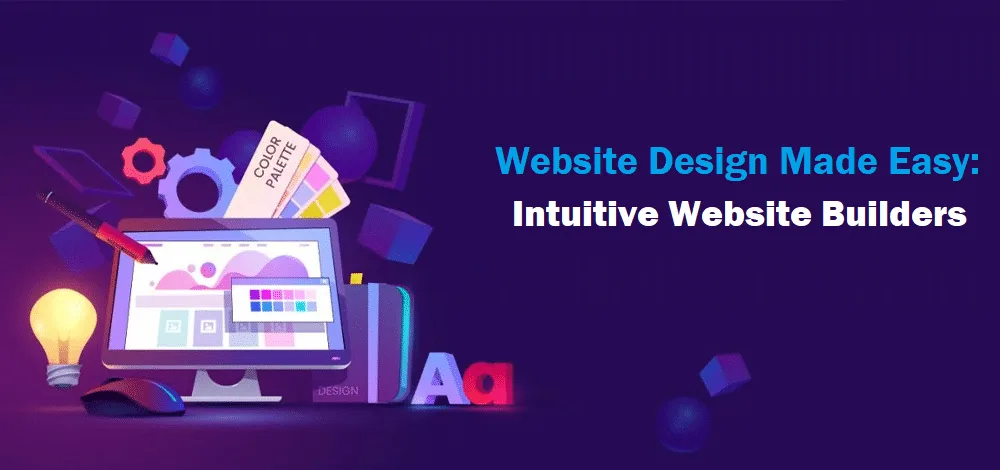The days of relying solely on web developers to create your online presence are fading fast. Intuitive website builders have stepped in, empowering anyone – regardless of technical experience – to bring their website vision to life. These drag-and-drop tools give you the freedom to design beautiful, professional-looking websites without a single line of code.
If you’re ready to take control of your website, there’s never been a better time. Intuitive website builders streamline the process, putting stunning design and seamless functionality within your reach. Get ready to explore the power of this simplified approach to website creation!
What are Intuitive Website Builders?
Intuitive website builders are like having your own digital design toolkit. They break down the complexities of website development with a focus on visual editing and user-friendliness. Here’s what sets them apart:
- Drag-and-Drop Interfaces: Instead of wrestling with code, you simply drag and place elements like text boxes, images, videos, and buttons directly onto your website layout. This visual approach is incredibly empowering and makes website design accessible to even the most novice users.
- Pre-designed Templates & Content Blocks: Think of these as a launchpad for your creativity. Templates provide a ready-made website structure, saving you time and effort. Content blocks offer pre-designed sections like headers, footers, contact forms, and galleries, streamlining the design process.
- Customization Galore: Intuitive website builders are about control. Easily adjust colors, fonts, layouts, and spacing to match your specific vision. Most builders offer extensive customization options, ensuring that your website reflects your unique brand.
Benefits of Intuitive Website Builders:
- Accessibility: Lower the barrier to entry for designing websites, regardless of your technical skills.
- Faster Time to Launch: Intuitive builders often allow for a remarkably fast website launch compared to traditional code-heavy development.
- Potential Cost Savings: By reducing the reliance on web developers, you can save on development costs.
Elementor: Leading the Way in Intuitive Website Design
Within the realm of intuitive website builders, Elementor stands tall as a truly exceptional solution, particularly for WordPress users. Here’s why it shines:
- Unmatched Ease of Use: Elementor’s drag-and-drop interface is remarkably intuitive. With real-time, live editing, you see your website transform instantly as you make changes, giving you unparalleled control and simplifying the design process.
- Design Powerhouse: Beyond the basics, Elementor offers a vast array of widgets (content elements), customization options, and advanced features such as a theme builder, popup builder, and WooCommerce integration. This enables you to create everything from simple landing pages to complex online stores.
- Elementor Pro & Ecosystem: While Elementor has a free version, Elementor Pro unlocks its full potential. Pro users benefit from professional templates, additional widgets, and essential features for streamlined business website creation. Moreover, a thriving community and extensive resources on elementor.com provide invaluable support.
- WordPress Integration: Elementor is designed specifically for WordPress, the world’s most popular content management system. This means seamless integration with countless plugins and themes, allowing you to extend your website’s functionality with ease.
Elementor’s focus on visual building, flexibility, and a powerful WordPress-centric ecosystem make it a compelling choice for anyone seeking a user-friendly and robust website creation experience.
Building a Website with an Intuitive Builder (Step-by-Step) (400- 450 words)
Step 1: Choosing a Platform
The foundation of your intuitive website building journey is selecting the right platform. Here’s where we subtly weave in the benefits of Elementor and WordPress:
- WordPress + Intuitive Builder: This combination, exemplified by Elementor, offers remarkable versatility and freedom. WordPress provides a robust content management system, while Elementor gives you complete control over design. This combination is particularly well-suited for those seeking flexibility and long-term scalability.
- Closed-Source Builders: Some website builders operate independently of WordPress. These can be quick to set up, but often limit your customization options and make it more difficult to change platforms later or expand your website with additional features.
Step 2: Selecting a Template
Most intuitive website builders offer a vast library of pre-designed templates. These provide a fantastic starting point and can significantly speed up the design process. Consider:
- Purpose: Select a template that aligns with the kind of website you’re building (business, portfolio, blog, e-commerce, etc.).
- Customization: Templates are a base, so choose one that allows for the level of customization you desire. Elementor-made templates are a great option due to their focus on flexibility.
Step 3: Customizing Your Design
This is where the fun truly begins! Elementor’s intuitive tools empower you to truly personalize your site:
- Widgets: Drag and drop elements like text, images, buttons, forms, and more directly onto your pages. Elementor offers a rich selection to build out your site’s content.
- Colors & Fonts: Choose a color palette and font combinations that reflect your brand identity.
- Layouts: Modify column structures, spacing, and padding to achieve the perfect look for your website.
Customizing Your Design
- Advanced Features (Elementor Pro): Unlock even more power with features like the Theme Builder, where you can visually design your website’s headers, footers, blog archive pages, and more. Seamlessly integrate your branding and design elements across your entire website.
- Responsive Design: Ensure your website looks amazing on desktops, tablets, and smartphones. Elementor lets you tweak how your site appears on different screen sizes. This ensures a seamless user experience for all your visitors.
Step 4: Adding Content
Your website is more than just its appearance! Intuitive builders provide simple ways to add rich content:
- Text & Images: Easily incorporate text blocks, headings, and stunning images. Consider using Elementor Image Optimizer for streamlined images and faster loading times.
- Videos: Embed videos from popular platforms like YouTube and Vimeo to enhance your pages.
- Forms: Create contact forms, survey forms, and more to collect valuable information from your visitors.
- Other Elements: Explore advanced widgets like sliders, galleries, pricing tables, and social media feeds to add dynamic content to your website.
Step 5: Going Live!
Once you’re happy with your design, it’s time to publish:
- Domain Name: Either purchase a new domain or connect an existing one to your website.
- Publishing: Intuitive builders typically have a one-click publish button to make your website accessible to the world.
Note: If you opt for a WordPress solution like Elementor, choosing the right hosting provider is crucial for your website’s speed, security, and overall user experience. We’ll delve into this next!
The Importance of Hosting for Your Intuitive Website
Think of your website as a house and your hosting as the land it’s built on. Just as the quality of the land influences your house’s stability, the quality of your hosting greatly impacts your website’s performance, security, and scalability. Here’s a breakdown:
- Types of Hosting
- Shared Hosting: The budget-friendly option where multiple websites share resources on a single server. This can lead to slower speeds and security risks.
- VPS Hosting: Offers more dedicated resources, but often requires some technical knowledge to manage.
- Managed Cloud WordPress Hosting: Ideal for those prioritizing website performance and security. Providers handle server setup, updates, and optimizations, specifically tailored to WordPress sites.
- Why Managed Cloud WordPress Hosting Stands Out:
- Top-Tier Performance: Benefit from technologies like Cloudflare’s Enterprise CDN, Google Cloud Platform’s C2 servers, and various caching mechanisms for blazing-fast load times.
- Unwavering Security: Managed hosts often offer enhanced security with firewalls, malware protection, and proactive updates.
- Scalability: Easily handle traffic spikes without sacrificing your website’s speed or stability.
Elementor Hosting: For those using Elementor, Elementor Hosting offers a seamless solution. It’s specifically optimized for Elementor websites, ensuring a smooth, high-performance experience for both you as the builder and your website’s visitors.
Getting the Most Out of Your Intuitive Website
Your intuitive website is now live – that’s fantastic! Now, let’s ensure it works its hardest for you:
- Responsive Design (Continued): A responsive website looks great on all devices. Intuitive builders like Elementor have built-in tools for mobile and tablet optimization. Prioritize testing your website on different screen sizes to ensure a consistent user experience.
- SEO Basics: Help search engines like Google understand your website. This involves:
- Meta Descriptions: Write short, compelling descriptions that appear beneath your website’s title in search results.
- Sitemaps: Create a map of your website’s structure for easy indexing by search engines. Many SEO plugins for WordPress can help with this.
- On-page Optimization: Use relevant keywords within your content and image names to make your website relevant to search queries.
- Integrations
- Email Marketing: Connect your site to services like Mailchimp or ConvertKit to collect leads, send newsletters, and nurture your audience
- Social Media: Add social media icons and sharing buttons to encourage visitors to share your content.
- Analytics: Use Google Analytics (or other analytics tools) to track visitor behavior, traffic sources, and what’s working well on your site.
- E-commerce (if relevant): Intuitive website builders often integrate with solutions like WooCommerce to set up an online store. This involves:
- Product Pages: Create detailed descriptions, pricing, and high-quality product images.
- Payment Gateways: Set up secure payment processing methods like PayPal or Stripe.
- Shipping & Taxes: Configure shipping rates and tax rules for your target audience.
- Ongoing Maintenance:
- Updates: Keep your website builder, plugins, and themes updated to ensure security and compatibility.
- Backups: Implement regular backups to safeguard your website’s data. Elementor Hosting makes this easy with automatic daily backups.
When to Consider Help
Intuitive website builders are designed for DIY users. However, there may be times when seeking additional support is the best decision. Consider professional assistance if:
- Your Project is Complex: Websites with very specific functionality, extensive customizations, or unique integrations might be better handled by a developer familiar with Elementor.
- Time is Crucial: If you need your website launched quickly and don’t have the time to master the builder yourself, hiring a web designer can save time.
Resources for Support:
- Elementor Documentation: Elementor offers comprehensive documentation and tutorials on its website (elementor.com) to guide you through the process.
- Elementor Community: Join the active Elementor community forum for help and troubleshooting tips from fellow users and experts.
Conclusion
Intuitive website builders have revolutionized the web, putting stunning website creation within everyone’s reach. No longer do you need to rely on expensive developers or struggle with complex code to have a professional online presence.
With the right tools and a bit of exploration, you can build a website that reflects your unique vision and serves as a powerful platform for your business or personal brand. If you want exceptional ease of use, flexibility, and the benefits of WordPress, Elementor, along with its supportive community and resources on elementor.com, is an excellent place to start your website journey.





